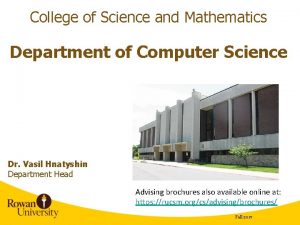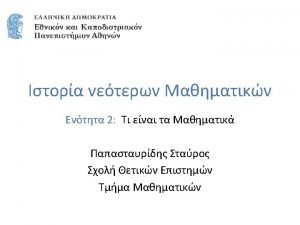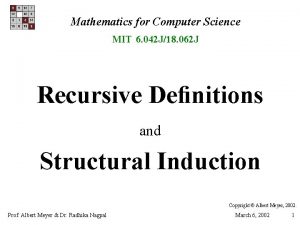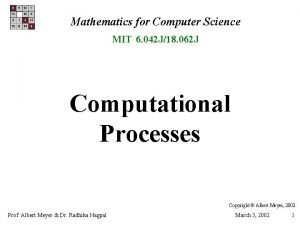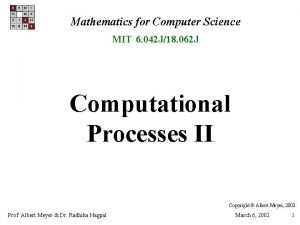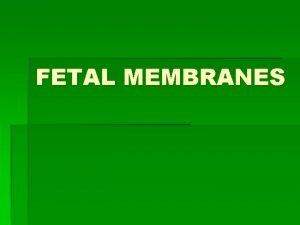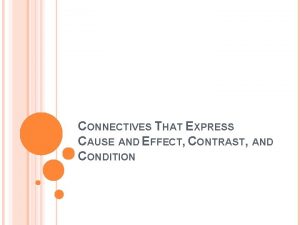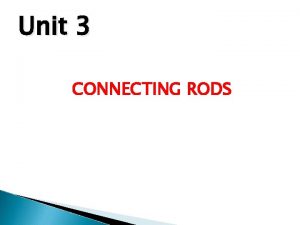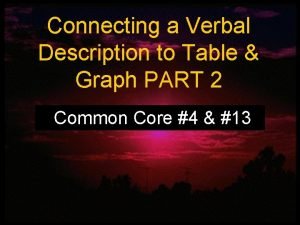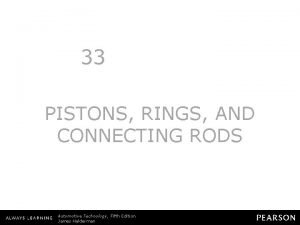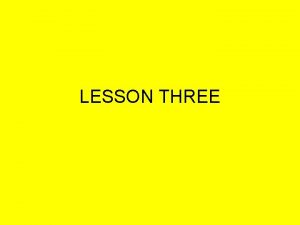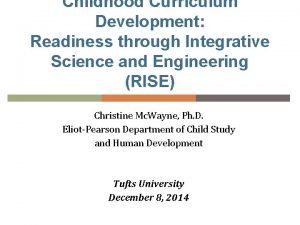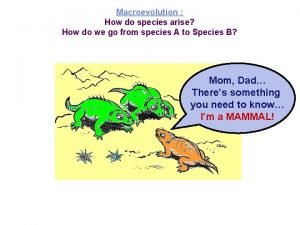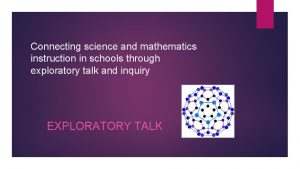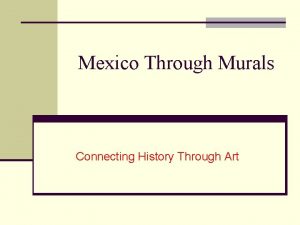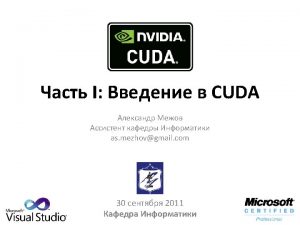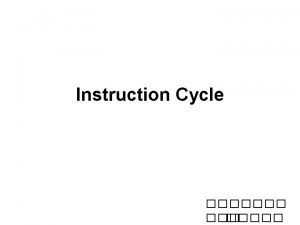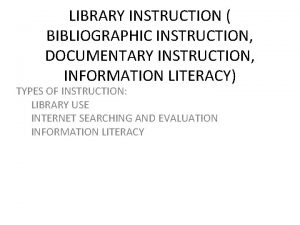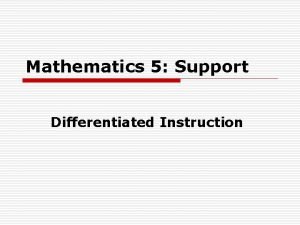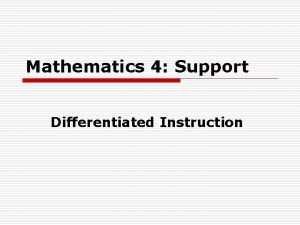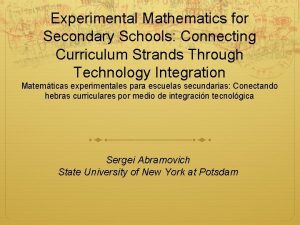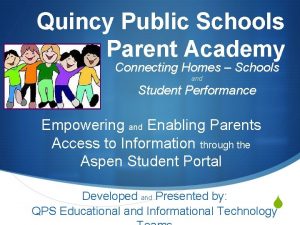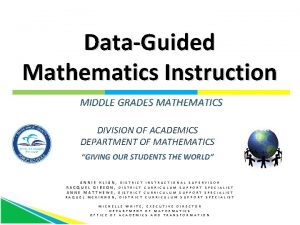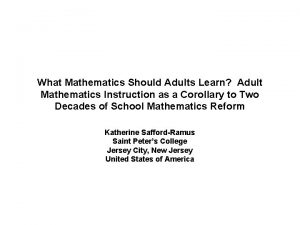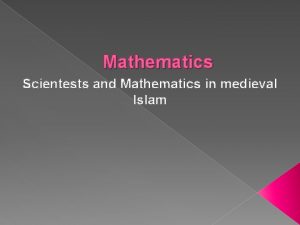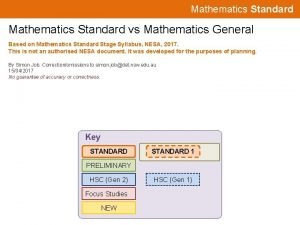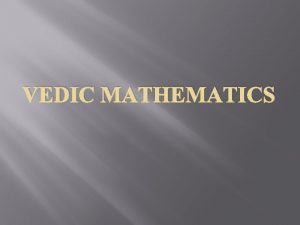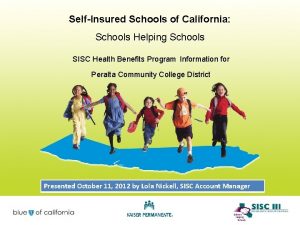Connecting science and mathematics instruction in schools through

























- Slides: 25

Connecting science and mathematics instruction in schools through exploratory talk and inquiry EXPLORATORY TALK

Dialogic pedagogy Robin Alexander – a dialogic teaching approach - to engage students in sustained stretches of talk which enables speakers and listeners to explore and build on their own and others’ ideas (Alexander, 2006) Epistemologically - knowledge emerges as an aspect of dialogue Education should be understood as engaging students in an ongoing process of shared enquiry taking the form of a dialogue (Wells, 1999; Linell, 2009). Wegerif (2017): all participants are given opportunities to participate with ideas, promoting knowledge and skills through shared inquiry developing dialogic dispositions promoting more dialogue as a valued end in itself

Dialogic pedagogy Dialogue can be used to lead students on a meaningful intellectual journey through a series of activities and lessons, so that they become able to demonstrate new, scientific forms of understanding. (From Dialogic teaching in science classrooms by Neil Mercer and Phil Scott)

Dialogic pedagogy Classroom dialogue: Does it really make a difference for student learning? A recent project - Sara Hennessy, Christine Howe, Neil Mercer, Maria Vrikki 72 teachers (144 lessons) - involving around 1700 children Key constructs: Elaboration, Reasoning, Querying/challenge, and Non-dialogic interaction. Results from project: High levels of Elaboration and Querying were positively associated with test scores (English and mathematics) either for teacher-student interaction or for student group participation

Mercer: Observations of group talk Disputational Talk Cumulative Talk There is a lot of disagreement and everyone Everyone simply accepts and agrees with just makes their own decisions. what other people say. There are few attempts to pool resources, or to offer constructive criticism. Children do use talk to share knowledge, but they do so in an uncritical way. There are often a lot of interactions of the 'Yes it is! – No it's not!' kind. The atmosphere is competitive rather than co-operative. Children repeat and elaborate each other's ideas, but they don't evaluate them carefully.

Mercer: Observations of group work Exploratory talk Everyone engages critically but constructively with each other’s ideas. Everyone shares relevant ideas, and everyone’s ideas are treated as worth consideration. Students ask each other questions and answer them. Reasons are given. Ideas are challenged and counter challenged. Reasons are given. When decisions are made, they are group decisions based on agreement Reasoning is visible in the talk


Thinking together project: Mercer, Wegerif and Dawes (1999) Mercer, N. , Wegerif, R. & Dawes, L. (1999). Children’s talk and the development of reasoning in the classroom. British Educational Research Journal, 25(1), 95 -111

Thinking together project Group talk before the Thinking Together lessons Trisha: Square and diamond, it's 2 George: No it's not Trisha: It is George: No it's not

Thinking together project Group talk after the Thinking Together lessons Trisha: That has got to be a diamond, a square with a diamond with a circle in that one, number 6, do you agree? George: No, what do you mean? Trisha: OK no it's got to be square Later. . . George: I don't understand this at all Trisha: Because look on that they've taken the circle out yes? So on that you are going to take the circle out because they have taken the circle out of that one George: On this they have taken the circle out and on this they have taken the diamond out and on this they have put them both in, so it should be a blank square because look it goes circle square

Exploratory Talk An example of dialogic pedagogy A didactic strategy to support dialogic pedagogy Exploratory talk and inquiry critical thinking

Engaging students in exploratory talk Cannot assume Exploratory Talk will just happen: Strategic management and development through explicit strategies to teach students to talk and collaborate Strategies: Stage 1: Raise students’ awareness of the value of talk as a tool for thinking Stage 2: Direct teaching of talk strategies Stage 3: Evaluating and evolving group talk (From Thinking Together Project, University of Cambridge and Talking Counts Project, University of Exeter)

Stage 1: Raising the awareness of talk Discuss what talk is effective for collaboration, model good/bad talk. Identify good talking words Agreeing the ground rules: Create a set of ground rules for talk. Display ground rules in the teaching room.

+ Examples of ‘rules for talk’ Example 1 Why don’t we try this? Do you agree? What do you think we should do? Is that right? How about? I have a different idea What else could we do? So do we all agree? I am not sure can you help me Why do you think that? Example 2 Listen to everyone Example 3 Have a reason for your answer I think. . . because. . Do you agree? I am not sure about this. . . can Ask questions What does everyone think? Look at the person speaking Help each other Everyone must agree Speak clearly you help me? What do you think?

Stage 2: Direct teaching of talk strategies Practising talk strategies: Include ground rules (one or two) as talk specific learning objective(s). Share and display these specific ground rules with the class for that activity. Teacher to model specific ground rule(s) – teacher to use the ground rule(s) when talking with students. Review use of talk learning objectives at end of activity/lesson.

Stage 3: Evaluating talk After three/four weeks: Carry out talk tallies – which types of talk do we use? Modify and develop the ground rules for group talk. Go back to Stage 2 with the modified ground rules (focus on rule as learning objective, model by teacher, review at end of the lesson).

Activities to practise talk Concept Cartoons https: //www. youtube. com/watch? v=9 Gd. Zfp. T 6 BVw&t=10 s Sensory experiences: https: //www. youtube. com/watch? v=Kp. Kv. Ei. Kme. B 0 Concept cartoons for science: http: //www. millgatehouse. co. uk/product/science-conceptcartoons-set-1/ Concept cartoons for mathematics: https: //www. atm. org. uk/Shop/Concept-Cartoons-in. Mathematics---Book/exs 004






What do you think? Jenny and Carly go shopping for shoes. Jenny chooses one pair for $110 and another for $100. Carly chooses a pair that costs $160. When they go to pay, the assistant says that there is a sale on and they get 3 pairs of shoes for the price of 2 pairs. Give two options for how much Jenny and Carly should each pay? Explain which of these options is fairer.

What do you think? The taxi fare is $3 flagfall (what you pay when you get into the taxi) and then $1. 50 per km after that. It does not matter how many people are in the taxi. Mike and Matt decide to share a taxi because they are going in the same direction but to different houses. The journey to Mike's house is 20 km, then a further 30 km to Matt's house. How much should each of them pay for the taxi? Explain why your suggestion is fair for both people.

Expectations for the project (For Discussion) December: Stage 1 (raising awareness of talk and agreeing ground rules) Term 2: Stage 2 and Stage 3: talk practice activities focusing on ground rules in maths and/or science twice a week. Use small groups (3 in each group). Integrate exploratory talk into Web. Quests. Evaluate and modify ground rules in relation to the Web. Quest
 Safety target and reach schools
Safety target and reach schools Huntsville city school powerschool
Huntsville city school powerschool Individualized instruction vs differentiated instruction
Individualized instruction vs differentiated instruction Direct vs indirect instruction
Direct vs indirect instruction My favorite subject in school is science
My favorite subject in school is science Tangental sawing
Tangental sawing International journal of science and mathematics education
International journal of science and mathematics education Rowan college of science and mathematics
Rowan college of science and mathematics Through one man sin entered the world, and through one man
Through one man sin entered the world, and through one man Furcation dental definition
Furcation dental definition The poet used candles and lanterns to
The poet used candles and lanterns to Mathematics
Mathematics Mathematics for computer science mit
Mathematics for computer science mit Mathematics for computer science mit
Mathematics for computer science mit Mathematics for computer science mit
Mathematics for computer science mit Allontois
Allontois Design of connecting rod ppt
Design of connecting rod ppt Conjunction cause and effect
Conjunction cause and effect Purpose of connecting rod
Purpose of connecting rod Connecting a verbal description to table and graph
Connecting a verbal description to table and graph Pistons rings and connecting rods
Pistons rings and connecting rods Copyright
Copyright Name the segments that are skew to cd
Name the segments that are skew to cd Marine ot desing
Marine ot desing Readiness through integrative science and engineering
Readiness through integrative science and engineering Connecting the concepts: macroevolution
Connecting the concepts: macroevolution







